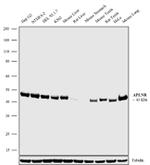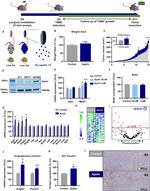Search Thermo Fisher Scientific
图: 1 / 2
Apelin Receptor Antibody (711101) in WB


产品信息
711101
种属反应
已发表种属
宿主/亚型
Expression System
分类
类型
克隆号
抗原
偶联物
形式
浓度
纯化类型
保存液
内含物
保存条件
运输条件
RRID
产品详细信息
This antibody is predicted to react with Monkey, Rabbit, Horse and Dog
Recombinant rabbit Superclonal™ antibodies are unique offerings from Thermo Fisher Scientific. They are comprised of a selection of multiple different recombinant monoclonal antibodies, providing the best of both worlds - the sensitivity of polyclonal antibodies with the specificity of monoclonal antibodies - all delivered with the consistency only found in a recombinant antibody. While functionally the same as a polyclonal antibody - recognizing multiple epitope sites on the target and producing higher detection sensitivity for low abundance targets - a recombinant rabbit Superclonal™ antibody has a known mixture of light and heavy chains. The exact population can be produced in every lot, circumventing the biological variability typically associated with polyclonal antibody production. Note: Formerly called “Recombinant polyclonal antibody”, this product is now rebranded as “Recombinant Superclonal™ antibody”. The physical product and the performance remain unchanged.
靶标信息
APLNR (Apelin Receptor) is a member of the G protein-coupled receptor gene family. The encoded protein is related to the angiotensin receptor, but is actually an apelin receptor that inhibits adenylate cyclase activity and plays a counter-regulatory role against the pressure action of angiotensin II by exerting hypertensive effect. It functions in the cardiovascular and central nervous systems, in glucose metabolism, in embryonic and tumor angiogenesis and as a human immunodeficiency virus (HIV-1) coreceptor. Two transcript variants resulting from alternative splicing have been identified.
仅用于科研。不用于诊断过程。未经明确授权不得转售。
生物信息学
蛋白别名: angiotensin II receptor-like 1; Angiotensin receptor-like 1; Apelin receptor; APJ (apelin) receptor; APJ receptor; B78; G protein-coupled receptor APJ; G-protein coupled receptor APJ; G-protein coupled receptor HG11; GPCR34; HG11 orphan receptor; MSR
基因别名: AGTRL1; APJ; APJR; APLNR; HG11; msr/apj
UniProt ID: (Human) P35414, (Rat) Q9JHG3, (Mouse) Q9WV08
Entrez Gene ID: (Human) 187, (Rat) 83518, (Mouse) 23796



